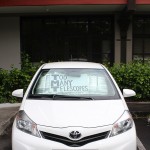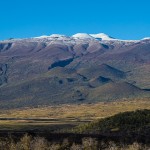Walking into the building I saw the first sign. A prominent message placed in the windshield of a car parked by the entrance… “TMT, Too Many Telescopes” The protesters were here. I had hoped they would not be, we had things to get done in this meeting. A disruption of the meeting by protesters would mean another delay.

To that end I had written a proposal for the new instruments with a description of exactly what we wished to do. Attached is an appendix of photos and drawings to answer any possible questions. I was present to answer the inevitable questions I had not thought of and feared would get asked.
The room was filling rapidly when we arrived, far beyond the usual audience of one of these meetings. As I greeted the many people I know, I noted many new faces. They seemed out of place, a little on edge, a sense of having entered enemy territory. Many of those present were young, in their teens and early twenties, one a young mother, child carried in her arms. The t-shirts betrayed their allegiance, they came with cameras and poorly concealed protest signs.
I have no problem with those who oppose the telescopes atop Mauna Kea attending a meeting like the OMKM board meeting. Public participation is a good thing. Indeed, these meetings are open to the public for a reason, to allow anyone interested to attend and to see for themselves how those charged with managing the mountain do their jobs.
I worried about a protest that would disrupt the meeting, making it impossible to accomplish anything. This did not happen. I will give those who attended credit for showing respect for the proceedings and to those discussing the effort of caring for the mountain.
As each item of board business was discussed the board members would ask questions first, followed by a chance for anyone in attendance to ask questions. It was then that the newcomers took their turn to express themselves and ask questions. All questions were given due respect, everyone listened. It was listening to those questions that I found interesting. Many of the questions asked by telescope opponents betrayed their ignorance of the significant effort that goes into caring for the mountain every day.
It is not just about telescopes. It is all aspects of land management… Native and endemic species monitoring, habitat restoration, invasive species monitoring and removal, visitor and tourism issues. All of these are covered by the management plan, all are managed by people who care about Mauna Kea. Many are professionals who have had their efforts called into question repeatedly in recent weeks.
There were summary reports from the entomologists who have been monitoring the native species and watching for invasives. The wēkiu bugs seem to have had a good winter. Reports on the volunteer efforts tallied the thousands of hours that people have spent pulling invasive weeds and running the visitor information station. The additional stress of the ongoing protest has strained the available facilities and personnel. Two additional part time rangers have been hired and are now on the job to assist.
At least one attendee, a protester who had camped out on the mountain from the start of the protests, made accusations about the actions of university staff. The issue was of course the discovery of invasive ants in the thatching material brought up to Hale Pohaku by the protesters to build a hale. How did the biologist find the ants when they did not? A UH biologist responded to the insulting accusations with style. Explaining that an untrained eye can easily miss many insects. He offered to take anyone interested outside after the meeting and show them just what he and his students do. How they monitor the arthropod populations of Mauna Kea. His enthusiasm for insects was infectious, I think he had a few who accepted his offer.
Since its adoption five years ago the Mauna Kea Comprehensive Management Plan is the governing document of Mauna Kea. The MKCMP and its sub-plans attempt to cover all aspects of human activity on Mauna Kea. Subjects such as public access and cultural resource management are addressed in sub-plans that require special attention. It is these documents that proscribe the activities of all of the mountain users; the observatories, the public tour companies, the natural resource managers.

It was at the end of another round of questions that one of the board members, silent to that point, directly responded to the protesters present. Describing himself as an apprentice kūpuna, Herring Kalua took those present to task about their relationship to the mountain.
Here is a man born and raised on the Big Island, who is a state highway construction supervisor, a professional, who has devoted his life to his community and volunteered with many service organizations. He dropped that western professional demeanor and addressed the protesters on completely Hawaiian terms. In traditional style he described his relationship with the community, his sense of place, told everyone who he is. He then asked everyone what they were trying to accomplish, what did they bring to the mountain, what they did for their community. It was a challenge to do the hard things that it really took to make things better.
I listened and learned as Uncle Kalua spoke, I have never really met him, in those few minutes he had my respect. To one who has not spent time in the islands his manner of speaking may have seemed odd. First to introduce oneself, to describe one’s accomplishments and relationships at length in place of a brief name and title. To give time and space for the message, to carefully press the message home. It is a slow form of argument, but one I have seen is quite effective. As he spoke his language was a melange of English and Hawaiian words. Many of the Hawaiian terms he used do not translate well, the concepts foreign to the western way of thinking. As he spoke you could hear respect appear in the voices of the protesters, as he spoke they responded.
In the end the business of the day was accomplished. Keck Observatory received approval for our new weather instruments. Each of the other agenda items were completed. While the protesters may have hoped to express their views, I believe that something else happened. Many of them learned a little about the work that goes into caring for our mountain. That despite so many recent and very public accusations of mismanagement and neglect, the reality is that there is a great deal of effort occurring. I would hope that some of those present realize that the way forward is to work with us to protect the mountain. It is the little things that count; ants, pulling weeds, meetings and writing plans. We need to make room at the table for all who care for Mauna Kea, to write the future of the mountain.
Update: A video of the meeting has been posted on YouTube…


Wow Andrew that was GOOD!
It should be on PUNAWEB?
aloha
Indeed, the questions asked by the “newcomers,” ad the manner in which they asked those questions, made it abundantly clear that they had no inkling who they were talking to, or how things worked. It was a little disappointing. Better that they should attend at least one meeting just to observe, before opening their mouths and looking silly.
Andrew, thank you for your insight into the recent OMKM Board meeting. I agree with your conclusion there is a lack of knowledge about what the hard planning that has been done. I only ask who’s fault is it the general public is so uninformed? We have been trying for years to make the outreach. But, it seems the public is not interested until there is a great controversy. I hope we find a better way to approach major questions like this in the future.
Andrew … My God what a well-written and thoughtful article. As someone who spent many years in meetings of this ilk I just want to say how impressed I am by your use and māna`o of the Hawaiian language and culture …especially for the diacritical marks which I know take so much effort to render correctly on the Web 😉 Your writing shows a dedication to the native Hawaiian language and culture I admit I didn’t think you’d pick up as well as you did when we first met, what? Over 10 years ago? You do honor to the mountain with your testimony. You give so much more than the colleagues you work with will ever know or appreciate. I want you to know that I and others who have followed this issue from the beginning respect you and are grateful for your insider’s perspective. I’m grateful you took the time and interest to learn the Hawaiian culture, language and ways surrounding this issue. You have adopted Hawaii Nei as your home, and the community benefits because of your ability to understand and interpret both sides so well. I really hope you will be recognized for the vital impact you play, not just now, but the effort you have put into it daily and weekly over the past several years.
I wish I understood the Hawaiian side as well as you seem to think I do. I try, but I know I fail. My viewpoint is far too western, very rooted in realism.